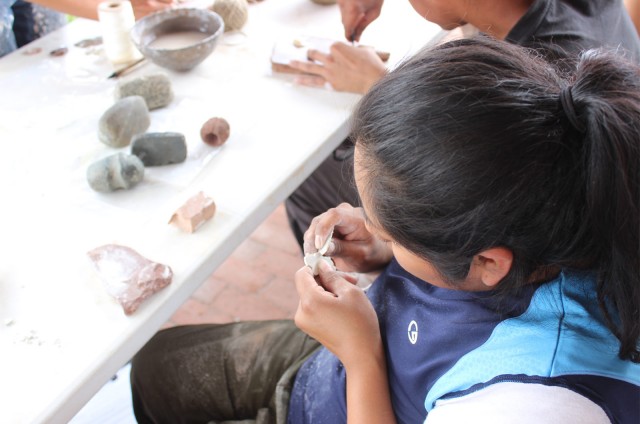- Home
- >
- Preservation Archaeology Blog
- >
- In the kaigim of our ancestors who once inhabited ...
Marcy Pablo, Tohono O’odham College
kaigim [guy-gym]—animal hide sandals (Tohono O’odham word for sandals)
My journey started out at our local Himdag Ki: cultural center and museum on the Tohono O’odham Nation. While taking a couple of archaeology classes at Pima Community College, I became interested in archaeology, and now I am attending my first archaeology field school. Being here for six weeks has taught me to appreciate where I come from and the land I reside on, and how the land was used in various ways throughout the past.
One way to appreciate the past is to take a journey, by isolating yourself from all things modern; here at field school I have found just that, and it’s not as bad as it sounds.
For example, visiting experts have guided us through traditional ways of making items. Potter Andy Ward came to camp and helped everybody make pottery. I made a medium-sized bowl with handles using a variation on the paddle and anvil technique, using a paddle of gourd to pat my pot smooth.

Ground stone expert Jenny Adams discussed how stone tools were used for utilitarian purposes, and then helped each student venture off to try grinding corn on metates, making bullroarers out of wood by grinding wooden slats on a rock slab, making jewelry out of shell, and making soapstone and argillite pendants. I chose to make a soapstone bird pendant and a turtle pendant out of argillite. My tools consisted of a 1×1-inch piece of sandstone and a flake. First I made my outline, then with a piece of sandstone I carefully ground the edges to make my figurine. Unfortunately, I was unsuccessful with my first turtle pendant, but that didn’t stop me from trying it again, this time using argillite rock with more success.
Experimental archaeology instructor Allen Denoyer taught us to make atlatls and do flintknapping. He also led us in debarking wood for the roof of the Salado-style adobe house within our campsite. For each of these activities we used non-metal tools, such as stone hammers, flaked stone, and broken volcanic rocks.
Surveying with Barry Price Steinbrecher also took me back to the ways of an earlier time, this time via a windmill. At our survey campsite, a windmill was our source of extra water; we took plenty of drinking water with us, but water for our solar shower bags had to be pumped by the windmill. Gathering water from the windmill was a challenge for me, as it was my first time using one. In order for the windmill to pump water, there must be breeze in the air. I stood at the windmill for a good seven minutes waiting for the windmill to spin and allow me to collect just enough water for my shower.

My project for our Archaeology Fair at the end of the course was on basketry, and in the same spirit I used no modern tools throughout the basket-making process. I used stone flakes for cleaning yucca fibers, and used a bone awl for splitting bear grass and sewing my basket together. I found that this process was a challenge, and I now have greater respect for my ancestral weavers who worked this way before me.
Take my advice—if you ever get the opportunity to be less modern, take it! You will not be disappointed.
Explore the News
-
Join Today
Keep up with the latest discoveries in southwestern archaeology. Join today, and receive Archaeology Southwest Magazine, among other member benefits.